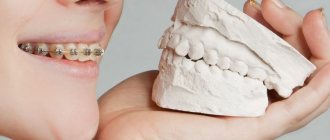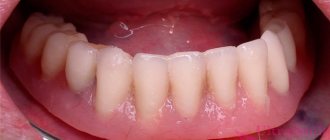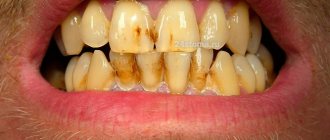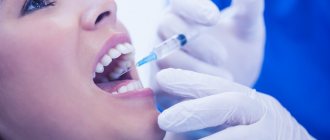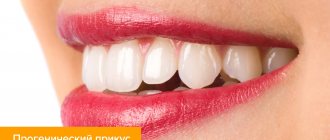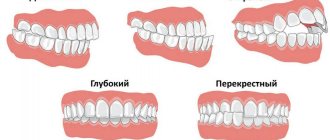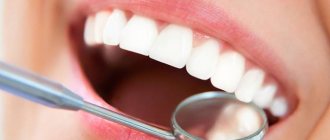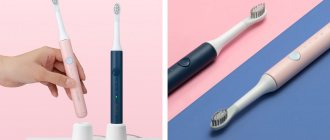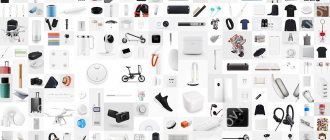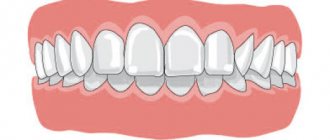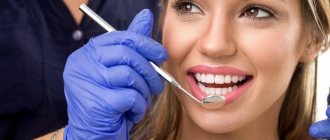How to correct the bite of an adult, how long does treatment take? Orthodontist Tatyana Gevorkyan, an orthodontist at the Star Smile clinic network, tells the story.
Orthodontist Tatyana Gevorkyan
The roots of teeth retain their ability to move throughout life. This makes it possible to correct the bite in adults, and there is no upper age limit. The main thing is that the teeth and their roots are healthy, then treatment can begin.
True, adults do not have the reserve of bone growth that young patients have. Simply put, you cannot install an orthodontic system and expect that the space in the row of teeth will increase on its own, and the system will only help guide the teeth into the desired position. The same pathologies in adults take longer to treat than in children, since additional space for teeth must be prepared using an orthodontic system. This is quite possible, but it takes more time.
Let’s take a closer look at what orthodontics can offer adult patients.
Types of occlusion defects and methods of their correction
Scientists have calculated that only 40% of the planet's inhabitants are the happy owners of an ideal bite. All others have deviations from the norm to one degree or another. Defects can be critical when they have a negative impact on human health, and practically unnoticeable, not leading to moral or physical discomfort.
The picture below shows occlusion anomalies:
Modern orthodontics includes several methods for correcting malocclusion:
- using braces;
- through surgery;
- using myotherapy (physical exercises) and non-braces corrective devices.
Can complications occur after orthognathic surgery?
The result of this surgical intervention is completely predictable, so complications after surgery in most cases should not occur. There may be temporary numbness of the lips. However, in the postoperative period this is acceptable and even helps the patient avoid pain. When the previous sensitivity of the lips returns, there is no more pain.
You can insure yourself against the negative consequences of surgery if you seek help from reliable specialists.
At what age should you start correcting your bite?
Dentists believe that occlusion correction can be carried out at any age using appropriate techniques. Thus, children are not treated with braces because their skeletal system is in active growth, and the bones, including the dentofacial apparatus, have not yet formed. Therefore, young children, before they have permanent teeth yet, are treated with myotherapy, plates and trainers. Note: such methods are used in the presence of non-critical developmental defects. Complex congenital pathologies that have a negative impact on the health or quality of life of the baby are treated surgically.
The optimal period of treatment with braces is from approximately 12 to 16 years. At older ages, the process takes longer.
Important: some dental anomalies can be corrected without the use of braces. The possibility of such treatment is determined by the doctor.
Artistic restoration of teeth
If there is no time or opportunity to fix a defect, it can be disguised. It is not advisable to put on braces or spend money on a set of aligners for the sake of 1-2 crooked teeth. You can change the appearance of dental crowns using composite materials. In this way, you can remove scars and diastemas, visually lengthen your teeth, and correct the cutting edges of your teeth.
Artistic restoration can also be used after treatment with orthodontic structures in order to bring the result to perfection, cover areas of enamel damage when removing locks, and disguise other defects.
As you can see, braces are not the only way to achieve a perfect smile. They are not suitable for everyone and not everyone needs them. To choose the most effective way to eliminate defects in the dentition, you can contact an orthodontist and listen to his opinion.
Corrective exercises – myotherapy
As a rule, myotherapy is an addition to the correction of occlusion using various orthodontic devices or as the main method in the treatment of children from 4 to 8 years old. Physical exercises help develop and strengthen facial muscles, stimulate bone growth, and have a positive effect on trophic processes.
Let's look at some effective exercises:
- to correct a deep bite: stand straight with your chin raised as much as possible. Move the lower jaw forward, then return to its original position. Repeat 15 – 17 times;
- to correct open occlusion: take a pencil (you can put a rubber tube on it), squeeze it with your teeth with adequate force. Perform for 4 – 5 minutes;
- with a crossbite: open your mouth as wide as possible, move your jaw towards the defect, close your jaws in the correct position for 5 seconds, then relax, then repeat the exercise again;
- to correct mesial occlusion: use your tongue to press on the inside of the front part of the upper dentition. Perform the exercise for 5 minutes.
Important: when performing any exercises of the myogymnastics complex there should be no pain. After each approach, you need to let the muscles relax for 1 minute.
Indications
- open lateral bite. It is characterized by the presence of a gap between the jaws: the face becomes asymmetrical, the functioning of the facial muscles is disrupted, and the risk of damage to the mandibular joint increases. The patient is unable to chew food or swallow/breathe normally;
- incorrect frontal closure. Provokes disruption of the chewing process, distorts diction;
- chin dysplasia. With this pathology, the configuration and shape of the chin are greatly changed, as a result of which the appearance deteriorates and problems arise with closing the lips and diction.
Contraindications
: age under 18 years, diabetes 2-3 degrees, diseases of the blood, heart muscle, blood vessels, individual intolerance to anesthesia, oncology.
Records
Vestibular plates are removable orthodontic devices. This means that they can be removed for a while, for example, to eat or brush your teeth. The plate for correcting pathologies is made individually for each patient using personal casts of the jaws.
The base of the plate is a plastic base that is adjacent to the palate. Arcs, clasps and screws are integrated into it. The base color can be neutral or colored.
These devices are mainly used in childhood and adolescence, when the dental system is not yet fully formed and therefore the dental elements are able to move relatively easily under the influence of directed force. The plates are also used to correct pathologies in adult patients, but only in mild cases.
Trainers
Orthodontic trainers are removable silicone covers for the teeth. They are worn for several hours a day: at night and for 2–4 hours during the day. They are used to correct occlusion in children and in simple situations (for example, when there are gaps between dental elements) in adults.
There are several types of trainers:
- standard for the initial stage of treatment - made of soft pink silicone. This period lasts about six months. The main goal is to influence the position of the jaws and facial muscles;
- standard for the final stage - made from harder blue silicone. They directly influence the movement of teeth in the dental row;
- Lm-activators are trainers, the unique feature of which is that they can be used before all teeth erupt, when the process is just beginning. Their use allows the teeth to settle into place immediately after eruption;
- myobraises – allow for early correction in a natural way, from the age of 3 years. The system does not work on the consequence, but on the causes of the formation of malocclusion. Myobraises are worn for 1 hour during the day and worn throughout the night.
The cost of braces: a brief overview
Of course, it is impossible to give exact prices at the moment: the cost of all braces, as well as dental services, is gradually increasing. In addition, the final amount depends on the condition of the teeth and the final design of the braces. But general information can be provided.
The most affordable braces systems are classic ones, which are classified as ligature, are installed on the outside of the teeth and are made of medical steel. Their cost ranges from several thousand rubles. Plastic systems of the same type cost approximately the same.
Ceramic ones will be more expensive - the bill will already be several tens of thousands of rubles. Sapphire ones will be slightly more expensive. Titanium and gold cost even more due to high prices for materials.
However, the cost is affected not only by the material from which the braces are made. In particular, you will have to spend at least 40 thousand rubles on non-ligature systems, even if they are created from ordinary medical steel. The reason is a more complex design and high requirements for the product. The same applies to lingual systems: they must be much smaller, but must provide the same fixation and pressure as conventional vestibular braces. Their cost can exceed 100 thousand rubles.
More accurate information on prices can be found by going to the price list section, or by contacting our manager by phone.
Mouth guards
Mouthguards, or aligners, are removable plastic or silicone transparent covers on the teeth. Made individually for a specific patient. They are worn constantly and are removed only for eating and hygiene procedures.
They are practically invisible, so they do not cause moral discomfort. The therapeutic effect is determined by a soft force effect on the dental elements, causing them to move in a given direction. The main disadvantage is the inability to eliminate particularly complex defects.
Important: the effectiveness of mouth guards for correcting malocclusion depends not only on the severity of the clinical case, but also on strict self-discipline. Failure to comply with the orthodontist's instructions will negate all efforts made.
Aligners
The third option for correcting malocclusion in adults is aligners, also known as orthodontic aligners.
Aligners
Correcting malocclusion in adults with the help of aligners is by far the most aesthetic method of treatment and also effective.
The advantages of aligners when correcting bites in adults:
- Aesthetics. They are completely transparent and invisible. Even during close communication, it is not noticeable that a transparent mouth guard is worn on the teeth. And at a slightly greater distance, in a photo or video, they are even more impossible to see.
- Possibility of 3D modeling. Everything can be visualized, and both the doctor and the patient see the final result of treatment on the model at the very beginning of treatment.
- The aligners are hygienic: they can be removed and performed oral hygiene without spending a lot of time. Brushing your teeth lasts the same two minutes as before. Plus one minute to clean your aligners.
- There are no restrictions on food intake because the aligners must be removed before eating. It is inconvenient to eat with them and is not recommended from the point of view of the safety of the aligners themselves. After eating, you will have to brush your teeth, but nothing interferes while eating.
- The frequency of doctor's appointments may be lower than when wearing braces, and the time spent in the dentist's chair is noticeably reduced. The patient is immediately given a set of aligners to replace them according to the scheme of one pair of aligners every two weeks. You need to visit your doctor once every 2-3 months to monitor treatment.
Disadvantages of aligners when correcting bites:
- A conditionally narrower range of anomalies that can be corrected. Although now aligners cope with quite complex cases (crossbite, open bite, impacted teeth), sometimes the treatment period with aligners is longer than with braces, and here the choice is up to the patient. We discuss such cases in advance.
- The price may be higher than that of braces when compared with metal ones. But this is a conditional disadvantage, since depending on the duration of treatment and the types of braces, the price of aligners may be lower.
